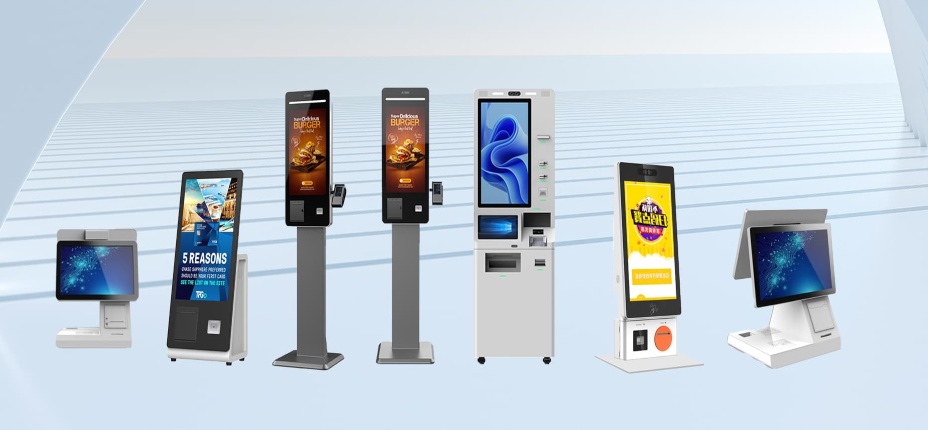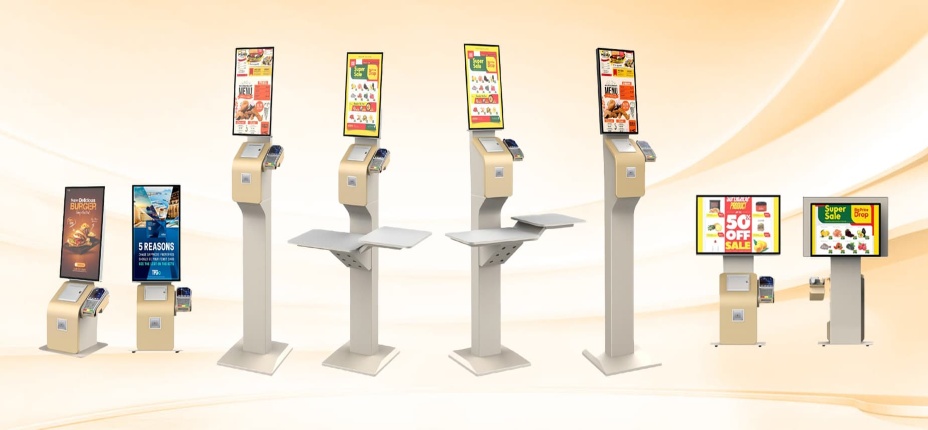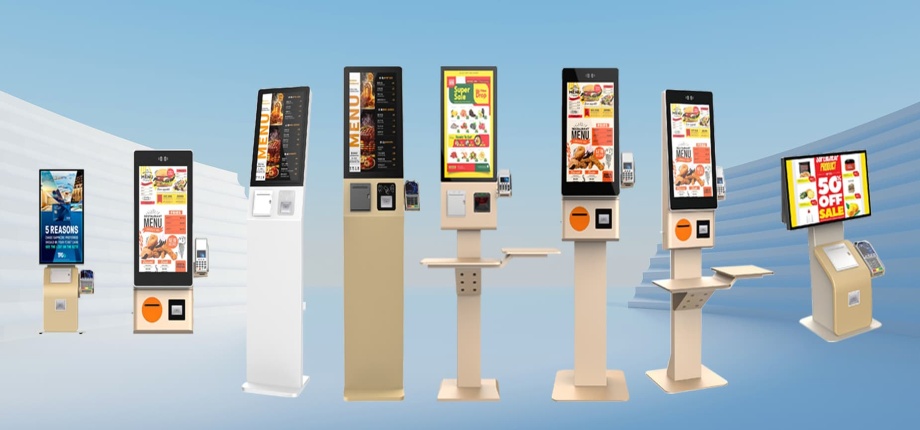





Self ordering kiosk comes in various types, each designed to meet specific business needs. Common types include countertop kiosks, ideal for limited space; freestanding kiosks, offering high visibility and accessibility; and wall-mounted kiosks, perfect for maximizing floor space. Additionally, outdoor self-ordering kiosks are built for durability in external environments, while tablet-based kiosks offer flexibility and mobility. These types cater to different settings, from quick-service restaurants to retail environments, enhancing customer experience and operational efficiency.
Welcome to our Types of Self Ordering Kiosk homepage. Here, we will comprehensively and carefully introduce the types, styes and designs of our self ordering kiosk. Each style and design has different costs and corresponds to various applications. Please read carefully and feel free to participate in the discussion. As a professional kiosk manufacturer, we are committed to providing the best self-ordering kiosk service in the world, and we look forward to collaborating with like-minded individuals who share our vision. |
|
Self ordering kiosk comes in various designs, each suited for specific business environments and customer needs. Below is an overview of the most common types, along with their features and applications.
| Type | Description | Typical Applications | Key Features |
|---|---|---|---|
| Freestanding Self Ordering Kiosk | A standalone unit with high visibility, ideal for high-traffic areas. | Quick-service restaurants, shopping malls, airports. | Large touchscreen, customizable branding, sturdy base. |
| Countertop Self Ordering Kiosk | Compact units that fit on countertops, perfect for smaller spaces. | Cafes, small retail stores, food courts. | Space-saving design, easy installation, user-friendly interface. |
| Wall-Mounted Self Ordering Kiosk | Mounted on walls to save floor space, suitable for tight areas. | Hospitals, offices, educational institutions. | Slim profile, secure mounting, easy access to controls. |
| Outdoor Self Ordering Kiosk | Weather-resistant kiosks built to withstand external environments. | Drive-thrus, parking lots, amusement parks. | Durable construction, waterproof, sunlight-readable screens. |
| Tablet-Based Self Ordering Kiosk | Portable kiosks using tablets for flexibility and mobility. | Pop-up shops, events, mobile businesses. | Lightweight, wireless connectivity, customizable apps. |
| Dual-Sided Self Ordering Kiosk | Kiosks with screens on both sides to serve multiple users simultaneously. | Busy restaurants, ticketing centers, large retail outlets. | Dual displays, efficient queue management, robust design. |
| Interactive Menu Board Self Ordering Kiosk | Large digital displays integrated with ordering functionality. | Fast food chains, cinema snack bars, large restaurants. | Interactive menu, integrated payment options, promotional capabilities. |

Freestanding Self Ordering KioskFreestanding self ordering kiosks are versatile and highly visible units that stand independently. They are ideal for areas with high foot traffic, offering a large touchscreen interface and customizable branding options. These kiosks are commonly used in quick-service restaurants, shopping malls, and airports. | Countertop Self Ordering KioskCountertop self-ordering kiosks are compact and designed to fit on countertops, making them perfect for businesses with limited space. They are often used in cafes, small retail stores, and food courts, providing an efficient and user-friendly ordering experience. |
Wall-Mounted Self Ordering KioskWall-mounted self-ordering kiosks are mounted directly on walls, saving valuable floor space. These kiosks are ideal for locations like hospitals, offices, and educational institutions, where space is at a premium. They feature a slim profile and secure mounting. | Outdoor Self Ordering KioskOutdoor self-ordering kiosks are designed for outdoor use and are built to withstand various environmental conditions, such as weather changes, extreme temperatures, and vandalism. These kiosks are commonly found in drive-thrus, theme parks, and public transportation hubs. |
Drive-Thru Self Ordering KioskDrive-Thru self ordering kiosks are specifically designed for use in drive-thru lanes of quick-service restaurants. These kiosks streamline the ordering process for customers in vehicles, providing a quick and efficient service. They are equipped with weather-resistant features and audio systems to facilitate clear communication. | Interactive Self Ordering KioskInteractive self ordering kiosks offer an engaging user experience by incorporating features like gesture recognition, voice commands, and multimedia content. These kiosks are often used in environments where enhanced customer interaction is desired, such as retail stores, hotels, and entertainment venues. |
Customizable self-ordering kiosks allow businesses to tailor the design, interface, and functionalities to meet specific needs. These kiosks can be adapted for various industries, including healthcare, retail, and hospitality, offering unique branding and specialized features to enhance customer engagement.

Choosing the right type of self ordering kiosk requires a thorough understanding of your business needs, customer preferences, and the environment in which the kiosk will be deployed. As an experienced manufacturer, we suggest you consider the following factors
Business Environment: Assess where the kiosk will be installed. For example, a drive-thru kiosk is ideal for quick-service restaurants, while a countertop model may suit a small café or retail store.
Customer Interaction: Evaluate how your customers interact with technology. If your target audience is tech-savvy, an interactive kiosk with features like gesture recognition or voice commands can enhance user experience.
Customization Needs: Determine the level of customization required. Some businesses benefit from fully customizable kiosks, which can be tailored to specific branding, functionality, or design requirements.
Space Constraints: Consider the available space. Wall-mounted or compact kiosks might be better suited for businesses with limited space, while larger floor-standing models offer more visibility and user engagement.
Budget: Align your choice with your budget. While advanced features and customization options can add value, they also increase costs. Balancing functionality with cost is key.
Durability and Maintenance: For high-traffic areas, choose kiosks that are durable and easy to maintain. Outdoor kiosks, for example, should be weather-resistant and robust.
Scalability: Consider future expansion. Select a kiosk that can be easily upgraded or integrated with new technologies as your business grows.
By carefully analyzing these factors, you can make an informed decision that ensures the kiosk aligns with your business objectives, enhances customer experience, and offers a good return on investment.

Self ordering kiosk comes in various designs, each tailored to meet specific business needs and environments. Floor-standing kiosks are the most common, offering versatility and visibility in high-traffic areas. These kiosks are ideal for quick-service restaurants and large retail stores, where space is ample, and customer engagement is a priority. Countertop kiosks are compact and perfect for businesses with limited space, such as cafes or small shops. They provide the same functionality as larger models but are more discreet. Wall-mounted kiosks save floor space and are ideal for businesses with limited real estate, such as fast-food chains or small retail outlets. They are also commonly used in healthcare settings for patient check-ins. Outdoor kiosks are designed for durability and weather resistance, making them perfect for drive-thru restaurants or parking facilities. When choosing a self-ordering kiosk, consider factors such as customer volume, space availability, and the environment in which the kiosk will be deployed. It’s crucial to match the kiosk type with your specific business needs to ensure maximum efficiency and return on investment.
Address: No. 99-15, Fuan intelligent manufacturing Industrial Park, Dayang Road, Fuhai Street, Baoan District, Shenzhen, China